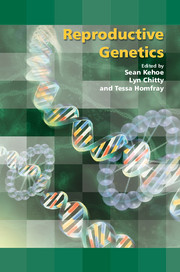Book contents
- Frontmatter
- Contents
- Participants
- Declarations of personal interest
- Preface
- 1 Genetic aetiology of infertility
- 2 Disorders of sex development
- 3 Preimplantation genetic diagnosis: current practice and future possibilities
- 4 Ethical aspects of saviour siblings: procreative reasons and the treatment of children
- 5 Epigenetics, assisted reproductive technologies and growth restriction
- 6 Fetal stem cell therapy
- 7 Prenatal gene therapy
- 8 Ethical aspects of stem cell therapy and gene therapy
- 9 Fetal dysmorphology: the role of the geneticist in the fetal medicine unit in targeting diagnostic tests
- 10 Fetal karyotyping: what should we be offering and how?
- 11 Non-invasive prenatal diagnosis: the future of prenatal genetic diagnosis?
- 12 Non-invasive prenatal diagnosis for fetal blood group status
- 13 Selective termination of pregnancy and preimplantation genetic diagnosis: some ethical issues in the interpretation of the legal criteria
- 14 Implementation and auditing of new genetics and tests: translating genetic tests into practice in the NHS
- 15 New advances in prenatal genetic testing: the parent perspective
- 16 Informed consent: what should we be doing?
- 17 Consensus views arising from the 57th Study Group: Reproductive Genetics
- Index
4 - Ethical aspects of saviour siblings: procreative reasons and the treatment of children
Published online by Cambridge University Press: 05 February 2014
- Frontmatter
- Contents
- Participants
- Declarations of personal interest
- Preface
- 1 Genetic aetiology of infertility
- 2 Disorders of sex development
- 3 Preimplantation genetic diagnosis: current practice and future possibilities
- 4 Ethical aspects of saviour siblings: procreative reasons and the treatment of children
- 5 Epigenetics, assisted reproductive technologies and growth restriction
- 6 Fetal stem cell therapy
- 7 Prenatal gene therapy
- 8 Ethical aspects of stem cell therapy and gene therapy
- 9 Fetal dysmorphology: the role of the geneticist in the fetal medicine unit in targeting diagnostic tests
- 10 Fetal karyotyping: what should we be offering and how?
- 11 Non-invasive prenatal diagnosis: the future of prenatal genetic diagnosis?
- 12 Non-invasive prenatal diagnosis for fetal blood group status
- 13 Selective termination of pregnancy and preimplantation genetic diagnosis: some ethical issues in the interpretation of the legal criteria
- 14 Implementation and auditing of new genetics and tests: translating genetic tests into practice in the NHS
- 15 New advances in prenatal genetic testing: the parent perspective
- 16 Informed consent: what should we be doing?
- 17 Consensus views arising from the 57th Study Group: Reproductive Genetics
- Index
Summary
‘Saviour siblings’ are children who are born through in vitro fertilisation (IVF) and are the product of the use of preimplantation genetic diagnosis (PGD) to select embryos that are a tissue match for a sibling who is in need of tissue or organ donation. Two cases that received a good deal of attention in the UK were the Hashmi and the Whitaker cases. In the former, Zain Hashmi had β-thalassaemia and could be cured using the cord blood of a tissue-matched sibling. In the latter, Charlie Whitaker had Blackfan–Diamond anaemia, which similarly could have been cured by a cord blood donation from a tissue-matched sibling. The relevant difference for the Human Fertilisation and Embryology Authority (HFEA) was that in the Hashmi case the tissue-matched sibling would also be selected so as to avoid having β-thalassaemia. In the Whitaker case, the embryo would have been selected solely as a match for Charlie.
In 2004, after conducting a review of the policy that led to these decisions, the HFEA modified its view. The current position is that preimplantation tissue typing will continue to be considered on a case-by-case basis for serious or life-threatening conditions and as a last-chance treatment. Preimplantation tissue typing ‘may be acceptable in cases in which the embryo to be tested is not itself at risk from the condition affecting the existing child’ and it may be used ‘with a view to using bone marrow from the resulting child.’
Keywords
- Type
- Chapter
- Information
- Reproductive Genetics , pp. 59 - 70Publisher: Cambridge University PressPrint publication year: 2009

